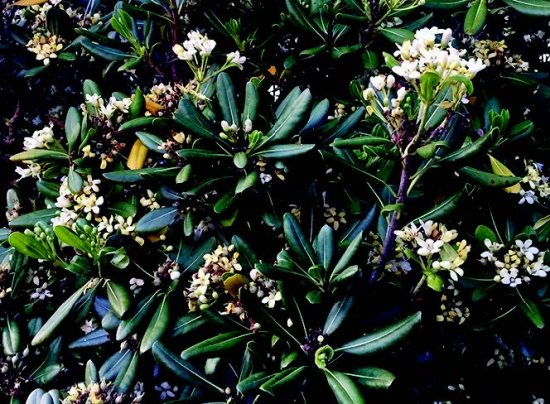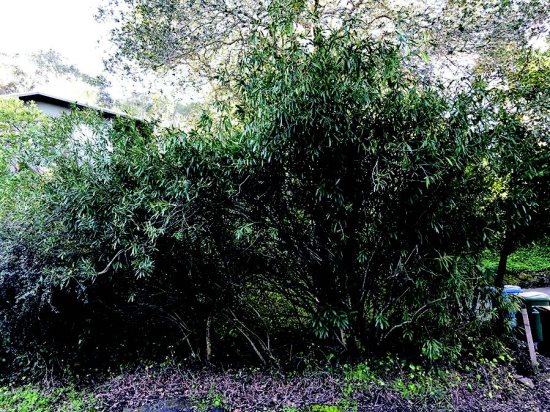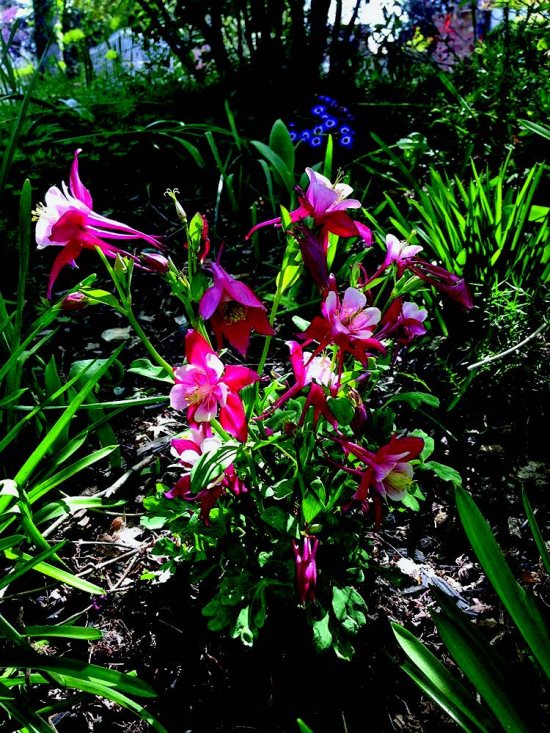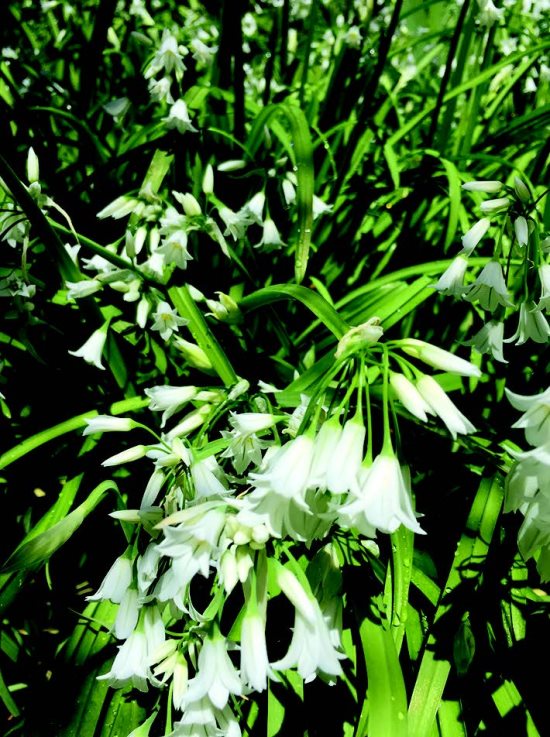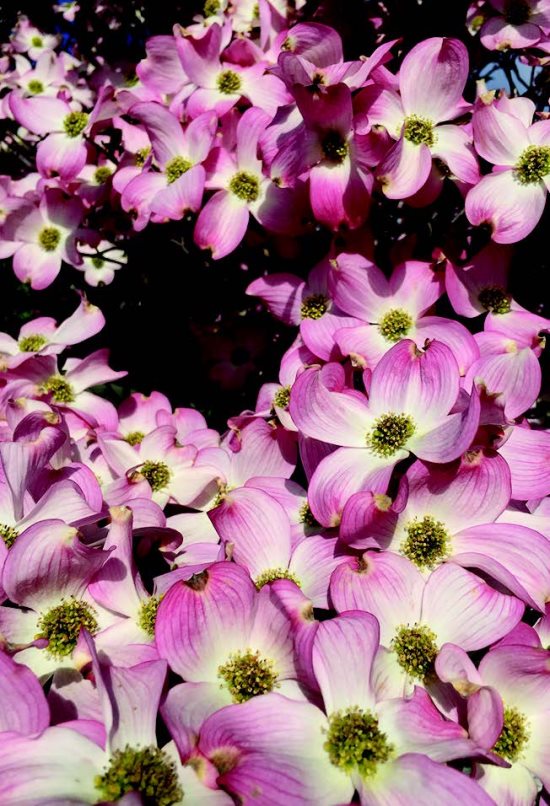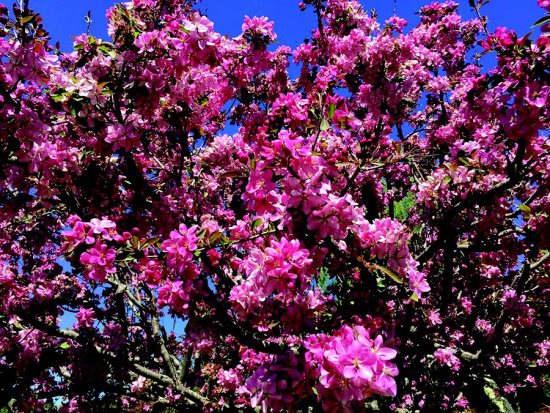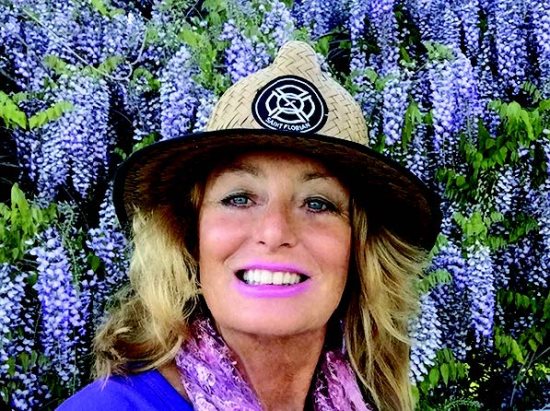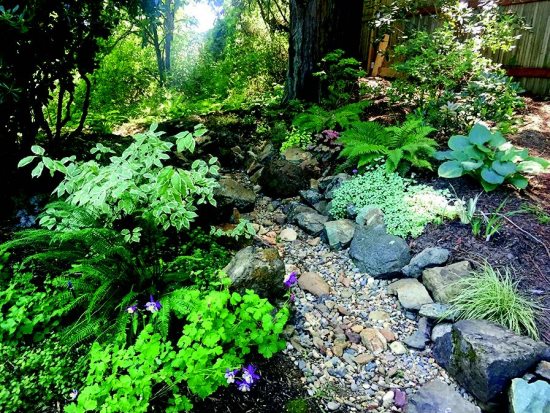 |
|
|
A dry creek riverbed with hosts and appropriates is helpful. Photo Cynthia Brian
|
|
|
|
|
|
"Some say the world will end in fire." - Robert Frost
 A running crown fire came rolling down the hillside toward our Lake County mountain cabin, moving faster than any human could run. All exits were blocked. Trees vaporized. Sixteen civilians trapped in the valley were being gathered in the meadow around our house. This acre of lush green grass would be the safety zone, everyone's last hope of survival. Ninety firefighters had been spread out along the roads, trails, and hillsides in the fire's path. Their orders were to stay put until the fire was upon them, then to light a backfire and escape to our meadow.
A running crown fire came rolling down the hillside toward our Lake County mountain cabin, moving faster than any human could run. All exits were blocked. Trees vaporized. Sixteen civilians trapped in the valley were being gathered in the meadow around our house. This acre of lush green grass would be the safety zone, everyone's last hope of survival. Ninety firefighters had been spread out along the roads, trails, and hillsides in the fire's path. Their orders were to stay put until the fire was upon them, then to light a backfire and escape to our meadow.
 The energy released was a hundred times that of a normal forest fire, with an explosive force nearing the intensity of a small atomic bomb. Everyone prayed. My sister and her husband said their goodbyes. Death seemed seconds away. Besides being a farmer, our dad had been captain of our volunteer fire department for 46 years. Dad built the safety zone. "Daddy," my sister prayed, "please don't let us die like this."
The energy released was a hundred times that of a normal forest fire, with an explosive force nearing the intensity of a small atomic bomb. Everyone prayed. My sister and her husband said their goodbyes. Death seemed seconds away. Besides being a farmer, our dad had been captain of our volunteer fire department for 46 years. Dad built the safety zone. "Daddy," my sister prayed, "please don't let us die like this."
 Then, almost imperceptibly, the roar began to diminish. The fire continued to rage for 14 days in nearby canyons, ultimately burning over 82,000 acres. At the time, it was the second-worst firestorm in United States history, the subject of national training videos for firefighters and showcased on an episode of the TV series, "20/20."
Then, almost imperceptibly, the roar began to diminish. The fire continued to rage for 14 days in nearby canyons, ultimately burning over 82,000 acres. At the time, it was the second-worst firestorm in United States history, the subject of national training videos for firefighters and showcased on an episode of the TV series, "20/20."
 I chronicled this epic true story in my book, "Be the Star You Are!r 99 Gifts for Living, Loving, Laughing, and Learning to Make a Difference." The chapter is appropriately titled The Gift of Survival. (First Editions available from http://www.CynthiaBrian.com/online-store).
I chronicled this epic true story in my book, "Be the Star You Are!r 99 Gifts for Living, Loving, Laughing, and Learning to Make a Difference." The chapter is appropriately titled The Gift of Survival. (First Editions available from http://www.CynthiaBrian.com/online-store).
 When a town called Paradise is transformed into burning hell incinerating everything in its path within 24 hours and becoming the deadliest and most destructive wildfire in California and United States history, it is prudent for Lamorindans to make fire safety a priority.
When a town called Paradise is transformed into burning hell incinerating everything in its path within 24 hours and becoming the deadliest and most destructive wildfire in California and United States history, it is prudent for Lamorindans to make fire safety a priority.
 A few months ago an Orinda resident reached out to me asking if I would write an article on how to landscape with fire prevention in mind. Melanie and Ken Light had contacted Moraga-Orinda Fire District Chief Dave Winnacker to find out how to become a Firewise neighborhood. Being fire wise is dependent on everyone in a neighborhood being diligent about keeping their property fire safe because fires do not honor property lines. If one home's landscape is pristine and the neighbor next door has overgrown bushes, brush, or low hanging trees, all of the properties become indefensible.
A few months ago an Orinda resident reached out to me asking if I would write an article on how to landscape with fire prevention in mind. Melanie and Ken Light had contacted Moraga-Orinda Fire District Chief Dave Winnacker to find out how to become a Firewise neighborhood. Being fire wise is dependent on everyone in a neighborhood being diligent about keeping their property fire safe because fires do not honor property lines. If one home's landscape is pristine and the neighbor next door has overgrown bushes, brush, or low hanging trees, all of the properties become indefensible.
 Lamorinda is rural, wooded, and has minimal escape routes. Many of the plants and trees growing throughout our area are highly flammable including pines, cypress, cedar, fir, bamboo, acacia, juniper, Pampas grass, rosemary, ivy, arborvitae, miscanthus and eucalyptus. Heat moves up and many homes are on hills. Fire speed and severity is stronger on slopes where vegetation management is crucial.
Lamorinda is rural, wooded, and has minimal escape routes. Many of the plants and trees growing throughout our area are highly flammable including pines, cypress, cedar, fir, bamboo, acacia, juniper, Pampas grass, rosemary, ivy, arborvitae, miscanthus and eucalyptus. Heat moves up and many homes are on hills. Fire speed and severity is stronger on slopes where vegetation management is crucial.
 Just as there is no such thing as a deer-proof plant, a fire-proof plant is a myth. Under the right conditions, every plant will burn. Referring to a plant as "fire safe" means that it tends not to be a significant fuel source by itself. Some plants chemical compositions resist heat and combustion.
Just as there is no such thing as a deer-proof plant, a fire-proof plant is a myth. Under the right conditions, every plant will burn. Referring to a plant as "fire safe" means that it tends not to be a significant fuel source by itself. Some plants chemical compositions resist heat and combustion.
 It is critical to keep plants around our homes well maintained and pruned as a fire protection tool. The closer plants are to the house, the more care is needed.
It is critical to keep plants around our homes well maintained and pruned as a fire protection tool. The closer plants are to the house, the more care is needed.
 Firescaping is simply a landscape design that reduces house and property vulnerability to wildfire. While enhancing the beauty of the property, we surround the house with plants that are less likely to ignite and create a defensible space.
Firescaping is simply a landscape design that reduces house and property vulnerability to wildfire. While enhancing the beauty of the property, we surround the house with plants that are less likely to ignite and create a defensible space.
 Characteristics of Highly Flammable Flora
Characteristics of Highly Flammable Flora
 - Dry and dead leaves, twigs, branches
- Dry and dead leaves, twigs, branches
 - Abundant, dense foliage
- Abundant, dense foliage
 - Needles
- Needles
 - Low moisture foliage
- Low moisture foliage
 - Peeling, loose bark
- Peeling, loose bark
 - Gummy sap
- Gummy sap
 - Leathery or aromatic leaves
- Leathery or aromatic leaves
 - High resin, terpene, or oil content
- High resin, terpene, or oil content
 - High, uncut or dry grasses
- High, uncut or dry grasses
 Characteristics of Fire-Resistant Flora
Characteristics of Fire-Resistant Flora
 - Hardy, slow growing plants that don't produce litter or thatch
- Hardy, slow growing plants that don't produce litter or thatch
 - Native plants that are drought tolerant with internal high water content. Generally, California natives are more tolerant of deer and fire.
- Native plants that are drought tolerant with internal high water content. Generally, California natives are more tolerant of deer and fire.
 (see Nature's Natives: April 17, 2019, https://www.lamorindaweekly.com/archive/
(see Nature's Natives: April 17, 2019, https://www.lamorindaweekly.com/archive/
 issue1304/Digging-Deep-with-Cynthia-Brian-for-
issue1304/Digging-Deep-with-Cynthia-Brian-for-
 April-Natures-Natives.html)
April-Natures-Natives.html)
 - Trees with thick bark that restrict the growth of invasive shrub species and hardwood trees such as walnut, cherry, maple, and poplar are less flammable. Deciduous trees and shrubs are generally more fire resistant because they have a higher moisture content when in leaf, lower fuel volume when dormant, and usually do not contain flammable oils.
- Trees with thick bark that restrict the growth of invasive shrub species and hardwood trees such as walnut, cherry, maple, and poplar are less flammable. Deciduous trees and shrubs are generally more fire resistant because they have a higher moisture content when in leaf, lower fuel volume when dormant, and usually do not contain flammable oils.
 - Supple, moist leaves with little to no sap or resin residue.
- Supple, moist leaves with little to no sap or resin residue.
 - Low growing ground covers.
- Low growing ground covers.
 - Bulbs.
- Bulbs.
 How to Create a Fire-Resistant Landscape:
How to Create a Fire-Resistant Landscape:
 - Include fire-resistant features such as pavers, bricks, pavement, gravel, rocks, mulch, dry creek beds, fountains, ponds, pools, and lawns. Water features including ponds, streams, and pools can be helpful fuel breaks.
- Include fire-resistant features such as pavers, bricks, pavement, gravel, rocks, mulch, dry creek beds, fountains, ponds, pools, and lawns. Water features including ponds, streams, and pools can be helpful fuel breaks.
 - Select high moisture plants that grow close to the ground with a low sap and resin content. (See an included list of plants, shrubs and trees)
- Select high moisture plants that grow close to the ground with a low sap and resin content. (See an included list of plants, shrubs and trees)
 - Maintain all plants and lawns. Clover, groundcovers and grasses that are kept low and green through irrigation are excellent alternatives. Mow, prune, water and space appropriately.
- Maintain all plants and lawns. Clover, groundcovers and grasses that are kept low and green through irrigation are excellent alternatives. Mow, prune, water and space appropriately.
 - Leave space between plants.
- Leave space between plants.
 - Minimize the inclusion of evergreen trees within 30 feet of structures. Clear debris and understory. Have clearance of all trees within 20 feet of chimneys.
- Minimize the inclusion of evergreen trees within 30 feet of structures. Clear debris and understory. Have clearance of all trees within 20 feet of chimneys.
 ?Remove invasive species or swaths of flammable plants including ivy, rosemary, broom and juniper.
?Remove invasive species or swaths of flammable plants including ivy, rosemary, broom and juniper.
 - Moist mulch, rocks or gravel can be used for firescaping. (Bark and leaf mulch can ignite unless sufficiently wet. Usage not recommended near structures.)
- Moist mulch, rocks or gravel can be used for firescaping. (Bark and leaf mulch can ignite unless sufficiently wet. Usage not recommended near structures.)
 - When planting trees, identify the tree size at maturity.
- When planting trees, identify the tree size at maturity.
 - Prune trees carefully to remove the possibility of fire laddering.
- Prune trees carefully to remove the possibility of fire laddering.
 - Arrange plantings in clusters and islands, with those near structures being smaller.
- Arrange plantings in clusters and islands, with those near structures being smaller.
 - Consider the combustibility of decorative features such as gazebos, fences, sheds, porches, and junk areas. Keep appropriate clearance to reduce the threat of burning embers.
- Consider the combustibility of decorative features such as gazebos, fences, sheds, porches, and junk areas. Keep appropriate clearance to reduce the threat of burning embers.
 - Bare ground is not recommended due to soil erosion.
- Bare ground is not recommended due to soil erosion.
 General Rules of Fire Safety
General Rules of Fire Safety
 Heed the checklist from our local fire departments to create a defensible space around your home. To reiterate fire district recommendations:
Heed the checklist from our local fire departments to create a defensible space around your home. To reiterate fire district recommendations:
 - Prevent embers from igniting your home by clearing leaves, needles, and debris from gutters, eaves, porches and decks.
- Prevent embers from igniting your home by clearing leaves, needles, and debris from gutters, eaves, porches and decks.
 - Mow grasses and weeds.
- Mow grasses and weeds.
 - Keep your garden watered.
- Keep your garden watered.
 - Prune tree limbs to keep the lowest branches 6-10 feet from the ground.
- Prune tree limbs to keep the lowest branches 6-10 feet from the ground.
 - Reduce "fire fuel laddering" by not allowing bushes or trees to touch one another.
- Reduce "fire fuel laddering" by not allowing bushes or trees to touch one another.
 - Keep combustible materials 15-30 feet away from structures.
- Keep combustible materials 15-30 feet away from structures.
 - Maintain your property and be alert for any fire danger.
- Maintain your property and be alert for any fire danger.
 For further safety tips visit www.mofd.org/fire-prevention/abatement.
For further safety tips visit www.mofd.org/fire-prevention/abatement.
 Through proper plant selection, placement and maintenance, we are able to diminish the possibility of ignition, lower fire intensity, and reduce the spread, helping our homes to survive the blaze. A fire-resistant landscape reduces the risk to our homes while enabling firefighters a place to defend our structures.
Through proper plant selection, placement and maintenance, we are able to diminish the possibility of ignition, lower fire intensity, and reduce the spread, helping our homes to survive the blaze. A fire-resistant landscape reduces the risk to our homes while enabling firefighters a place to defend our structures.
 Helpful Websites:
Helpful Websites:
 National Fire Protection Association: www.nfpa.org
National Fire Protection Association: www.nfpa.org
 Moraga-Orinda Fire District: www.mofd.org
Moraga-Orinda Fire District: www.mofd.org
 Fire Safe Marin (We are not in Marin, but this is a great resource): www.firesafemarin.org
Fire Safe Marin (We are not in Marin, but this is a great resource): www.firesafemarin.org
 Pacific Northwest Fire Resistant
Pacific Northwest Fire Resistant
 Plants: www.firefree.org/wp-content/uploads/2016/02/Fire-Resistant-Plants.pdf
Plants: www.firefree.org/wp-content/uploads/2016/02/Fire-Resistant-Plants.pdf
 University of California Cooperative Extension: https://ucanr.edu/sites/fire/Prepare/Landscaping/Plant_choice/
University of California Cooperative Extension: https://ucanr.edu/sites/fire/Prepare/Landscaping/Plant_choice/
 Las Pilitas Nursery (although this nursery is in Santa Margarita it has the best website that gives burn times for various plants. Plus it also has deer resistant information as well.) www.laspilitas.com/easy/deerfire.htm
Las Pilitas Nursery (although this nursery is in Santa Margarita it has the best website that gives burn times for various plants. Plus it also has deer resistant information as well.) www.laspilitas.com/easy/deerfire.htm
 Sign Up for Alerts:
Sign Up for Alerts:
 Contra Costa County Community Warning System: https://cwsalerts.com
Contra Costa County Community Warning System: https://cwsalerts.com
 Alerts for Your Specific Area: www.nixle.com
Alerts for Your Specific Area: www.nixle.com
 Sample Listing of Plants that are Fire-Resistant
Sample Listing of Plants that are Fire-Resistant
 (I reiterate, no plant is fire-proof. Maintenance, pruning, watering, spacing, location are all extremely important elements for fire safety.)
(I reiterate, no plant is fire-proof. Maintenance, pruning, watering, spacing, location are all extremely important elements for fire safety.)
 Bulbs (tulips, daffodils, iris, hyacinth, freesia, etc. Cut stalks to the ground when leaves are dry)
Bulbs (tulips, daffodils, iris, hyacinth, freesia, etc. Cut stalks to the ground when leaves are dry)
 California redbud
California redbud
 Sage
Sage
 Penstemon
Penstemon
 Heather
Heather
 Fuchsia
Fuchsia
 Columbine
Columbine
 Thyme
Thyme
 Poppy
Poppy
 Wild strawberry
Wild strawberry
 Common yarrow
Common yarrow
 French lavender
French lavender
 Lilac
Lilac
 Coreopsis
Coreopsis
 Ajuga
Ajuga
 California lilac
California lilac
 Society garlic
Society garlic
 Alliums
Alliums
 Dianthus
Dianthus
 Yellow or Purple ice plant
Yellow or Purple ice plant
 Creeping phlox
Creeping phlox
 Lamium
Lamium
 Sedum
Sedum
 Succulents
Succulents
 Veronica
Veronica
 Armeria
Armeria
 Agapanthus
Agapanthus
 Trumpet Vine
Trumpet Vine
 Daylily
Daylily
 Heuchera
Heuchera
 Hosta
Hosta
 Red hot poker
Red hot poker
 Lupine
Lupine
 Delphinium
Delphinium
 Echinacea
Echinacea
 Lamb's ear
Lamb's ear
 Yucca
Yucca
 Roses
Roses
 Salvia
Salvia
 Evening primrose
Evening primrose
 Daphne
Daphne
 Boxwood
Boxwood
 Rhododendron
Rhododendron
 Spirea
Spirea
 Dogwood
Dogwood
 Mock orange
Mock orange
 Azalea
Azalea
 Current
Current
 Viburnum
Viburnum
 Horse chestnut
Horse chestnut
 Liquid Amber
Liquid Amber
 Honey locust
Honey locust
 Crabapple
Crabapple
 Purple robe locust
Purple robe locust
 Fruit trees (varieties of cherry, plum, pear, peach, apricot)
Fruit trees (varieties of cherry, plum, pear, peach, apricot)
 Black oak
Black oak
 Hawthorne
Hawthorne
 Birch
Birch
 Aspen
Aspen
 Poplar
Poplar
 Maple
Maple
 Manzanita (prune without dead wood)
Manzanita (prune without dead wood)
 Walnut
Walnut
 Harry Houdini wrote, "Fire has always been and seemingly, will always remain, the most terrible of the elements." Use your common sense. If you need additional help, consult a professional. Contact your fire department for a Fire Wise walk. Invite neighbors to a meeting. Come talk to me at the Be the Star You Are!r charity booth at the Moraga Community Faire from 11 a.m. to 3 p.m. on Saturday, May 11. Buy garden gifts for Mother's Day. (Http:/www.BethestarYouAre.org/events)
Harry Houdini wrote, "Fire has always been and seemingly, will always remain, the most terrible of the elements." Use your common sense. If you need additional help, consult a professional. Contact your fire department for a Fire Wise walk. Invite neighbors to a meeting. Come talk to me at the Be the Star You Are!r charity booth at the Moraga Community Faire from 11 a.m. to 3 p.m. on Saturday, May 11. Buy garden gifts for Mother's Day. (Http:/www.BethestarYouAre.org/events)
 Fires are in our future. Hopefully, we won't require a green meadow safety zone for survival, yet we need to be prepared. Make firescaping an ongoing conversation.
Fires are in our future. Hopefully, we won't require a green meadow safety zone for survival, yet we need to be prepared. Make firescaping an ongoing conversation.
 In the meantime, get out to weed, water, prune
In the meantime, get out to weed, water, prune
 and maintain. Do what you can to be fire safe.
and maintain. Do what you can to be fire safe.
 Happy Gardening.
Happy Gardening.
 Happy Growing. Happy Mother's Day!
Happy Growing. Happy Mother's Day!




|

